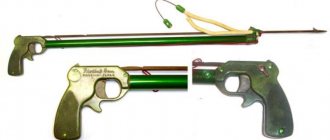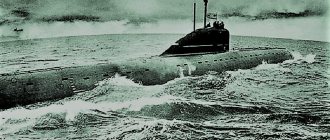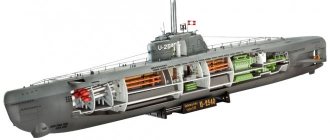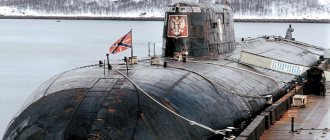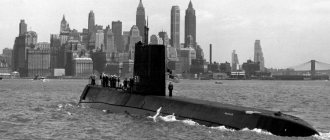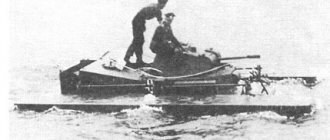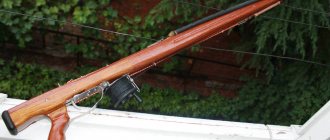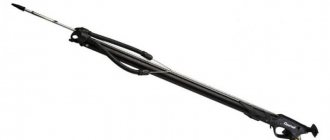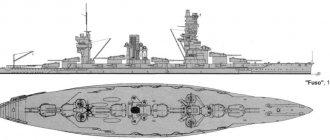Author: Yuri
03 March 2022 15:05
Tags: VSD submarine radio
15416
19
Since the invention of submarines, the problem of communication with them has arisen. The radio problem was solved. But in order to transmit and receive data, the boat needed to rise to the surface and give out its location. And the passage of HF radio waves is not always good. How to transmit an order without waiting for the next communication session, without unmasking the submarine? The gloomy German genius was one of the first to solve this problem.
German submarines and radio communications.
0
See all photos in the gallery
Radio communications in the Imperial German Navy were used from the very beginning of the First World War. It was also on German submarines. In his book “Ten Years and Twenty Days,” Grand Admiral Karl Dönitz, who was a submarine commander in World War I, gives the following description of the situation with radio communications on submarines that had developed by 1918: “Submarines fought only alone. They went out to sea, plowed the dark depths, broke through anti-submarine barriers, searched for the enemy, entered into battle - each on its own, without supporting each other. Radiotelegraphy, the only means of communication between submarines available at that time, did not allow for joint actions. At that time there were no long-wave or short-wave transmitters. While underwater, we were completely cut off from the world, and in order to transmit a long-wave signal while on the surface of the water, it was necessary to quickly stretch an antenna between two masts. The signal, despite the maximum power used, was very weak and was transmitted over a short distance. And during its transfer, the submarine was in a state of only partial readiness for diving, that is, it was more than usual vulnerable to enemy attack, while it itself could not attack at all.” Having become commander of the Kriegsmarine submarine forces, Karl Dönitz made every effort to develop them. He considered one of his main tasks to be the organization of control over the actions of submarines, which would have been impossible without the presence of high-quality radio communications, allowing boat commanders to receive radiograms from the submarine warfare headquarters and follow its instructions. How was radio communication organized on German submarines? It was divided into three ranges: short-wave (HF), medium-wave (MV) and ultra-long-wave (VLD). Communications in the HF range were the main one, since it made it possible not only to receive radiograms, but also to transmit messages to the headquarters of the submarine forces. Medium wave communication served mainly for radio exchange between boats and was used extremely rarely. The VLF-band connection was considered redundant with respect to the short-wave range. However, ultra-long waves had one very important advantage: they had the ability to penetrate water. This allowed German submarines, firstly, to receive radio messages at shallow depths under water - as opposed to messages transmitted on short waves, for which the boat had to surface to receive. Secondly, VHF communications made it possible to reliably receive radiograms at any time of the day and at any time of the year in areas of the globe remote from Europe, because it was much less dependent on ionospheric phenomena compared to shortwave. During the Second World War, when the range of German submarines expanded to the South Atlantic, and cruising submarines began to make trips to the Indian Ocean right up to the shores of Japan, the importance of VHF communications increased even more.
0
The main ultra-long wave receiver on German submarines was the T3PLLä38. Produced, it was used until the very end of the war.
×
0
General view of the T3PLLä38 radio receiver. The tuning scale shows five ranges: 70–150 kHz, 150–350 kHz, 350–640 kHz, 640–1200 kHz, 15–33 kHz.
0
0
It was connected to a gyrocompass and a retractable VLF/LW band antenna located on the submarine's wheelhouse, which rotated 360°. Having heard the signal he was interested in, the radio operator could determine the bearing to the signal source using a scale built into the table and showing data from the gyrocompass.
0
Loop antenna on the wheelhouse.
0
The mysticism of low frequencies. How to contact a submarine?
What a ridiculous question?
“How to contact a submarine” Take a satellite phone and call. Commercial satellite communication systems, such as INMARSAT or Iridium, allow you to call Antarctica without leaving your Moscow office. The only negative is the high cost of the call, however, the Ministry of Defense and Roscosmos probably have internal “corporate programs” with substantial discounts...
Indeed, in the age of the Internet, Glonass and wireless data transmission systems, the problem of communication with submarines may seem like a meaningless and not very witty joke - what problems could there be here, 120 years after the invention of radio?
But there is only one problem here - the boat, unlike airplanes and surface ships, moves in the depths of the ocean and does not respond at all to the call signs of conventional HF, VHF, DV radio stations - salty sea water, being an excellent electrolyte, reliably jams any signals.
Well... if necessary, the boat can surface to periscope depth, extend the radio antenna and conduct a communication session with the shore. Is the problem resolved? Alas, not everything is so simple - modern nuclear-powered ships are capable of staying underwater for months, only occasionally rising to the surface to conduct a scheduled communication session. The main importance of the issue is the reliable transmission of information from the shore to the submarine: will it really be necessary to wait a day or more to broadcast an important order - until the next scheduled communication session?
In other words, at the moment of the outbreak of a nuclear war, submarine missile carriers risk being useless - while battles are raging on the surface, the boats will continue to calmly write “figure eights” in the depths of the World Ocean, unaware of the tragic events occurring “above.” What about our nuclear retaliatory strike? Why are naval nuclear forces needed if they cannot be used in time? How do you even contact a submarine lurking on the seabed?
The first method is quite logical and simple, at the same time it is very difficult to implement in practice, and the range of such a system leaves much to be desired. We are talking about underwater sound communication - acoustic waves, unlike electromagnetic waves, propagate in the marine environment much better than through the air - the speed of sound at a depth of 100 meters is 1468 m/s!
All that remains is to install powerful hydrophones or explosive charges at the bottom - a series of explosions at a certain interval will clearly indicate to the submarines the need to surface and receive an important code message via radio communication. The method is suitable for operations in the coastal zone, but it will no longer be possible to “shout” the Pacific Ocean, otherwise the required power of explosions will exceed all reasonable limits, and the resulting tsunami wave will wash away everything from Moscow to New York.
Of course, it is possible to lay hundreds and thousands of kilometers of cables along the bottom - to hydrophones installed in the areas where strategic missile carriers and multi-purpose nuclear submarines are most likely to be located... But is there another, more reliable and effective solution?
Der Goliath. Fear of heights
It is impossible to circumvent the laws of nature, but each rule has its exceptions. The sea surface is not transparent for long, medium, short and ultra-short waves. At the same time, ultra-long waves, reflected from the ionosphere, easily spread beyond the horizon for thousands of kilometers and are capable of penetrating into the depths of the oceans.
A solution has been found - a communication system on ultra-long waves. And the non-trivial problem of communication with submarines has been solved!
But why do all radio amateurs and radio experts sit with such a sad expression on their faces?
Dependence of the penetration depth of radio waves on their frequency VLF (very low frequency) - very low frequencies ELF (extremely low frequency) - extremely low frequencies
Ultra-long waves are radio waves with a wavelength of over 10 kilometers. In this case, we are interested in the range of very low frequencies (VLF) ranging from 3 to 30 kHz, the so-called. "myriameter waves". Don’t even try to look for this range on your radios - to work with ultra-long waves you need antennas of amazing sizes, many kilometers long - none of the civilian radio stations operate in the “myriameter waves” range.
The monstrous dimensions of the antennas are the main obstacle to the creation of VLF radio stations.
And yet, research in this area was carried out in the first half of the 20th century - their result was the incredible Der Goliath (“Goliath”). Another representative of the German “wunderwaffe” is the world’s first ultra-long-wave radio station, created in the interests of the Kriegsmarine. Goliath's signals were confidently received by submarines in the area of the Cape of Good Hope, while the radio waves emitted by the super-transmitter could penetrate water to a depth of 30 meters.
Dimensions of the car compared to the Goliath support
The appearance of the Goliath is stunning: the VLF transmitting antenna consists of three umbrella parts mounted around three central pillars 210 meters high, the corners of the antenna are fixed to fifteen lattice masts 170 meters high. Each antenna sheet, in turn, consists of six regular triangles with a side of 400 m and is a system of steel cables in a movable aluminum shell. The antenna web is tensioned by 7-ton counterweights.
The maximum transmitter power is 1.8 Megawatts. Operating range 15 – 60 kHz, wavelength 5000 – 20,000 m. Data transfer rate – up to 300 bps.
The installation of a grandiose radio station in the suburb of Kalbe was completed in the spring of 1943. For two years, “Goliath” served in the interests of the Kriegsmarine, coordinating the actions of “wolf packs” in the vast Atlantic, until the “object” was captured by American troops in April 1945. After some time, the area came under the control of the Soviet administration - the station was immediately dismantled and taken to the USSR.
For sixty years the Germans wondered where the Russians hid the Goliath. Have these barbarians really let a masterpiece of German design go to waste? The secret was revealed at the beginning of the 21st century - German newspapers came out with loud headlines: “Sensation! "Goliath" has been found! The station is still in working order!”
The tall masts of the “Goliath” shot up in the Kstovsky district of the Nizhny Novgorod region, near the village of Druzhny - it is from here that the captured super-transmitter broadcasts. The decision to restore Goliath was made back in 1949; the first airing took place on December 27, 1952. And now, for more than 60 years, the legendary “Goliath” has been guarding our Fatherland, providing communication with naval submarines moving under water, while at the same time being a transmitter for the Beta precision time service.
Impressed by the capabilities of the Goliath, Soviet specialists did not stop there and developed German ideas. In 1964, 7 kilometers from the city of Vileika (Republic of Belarus), a new, even more ambitious radio station was built, better known as the 43rd communications center of the Navy.
Today, the VLF radio station near Vileika, along with the Baikonur Cosmodrome, the naval base in Sevastopol, bases in the Caucasus and Central Asia, is among the operating foreign military facilities of the Russian Federation. About 300 officers and midshipmen of the Russian Navy serve at the Vileyka communications center, not counting civilian citizens of Belarus. Legally, the facility does not have the status of a military base, and the territory of the radio station has been transferred to Russia for free use until 2022.
The main attraction of the 43rd communications center of the Russian Navy, of course, is the VLF radio transmitter “Antey” (RJH69), created in the image and likeness of the German “Goliath”. The new station is much larger and more advanced than captured German equipment: the height of the central supports increased to 305 m, the height of the side lattice masts reached 270 meters. In addition to the transmitting antennas, the territory of 650 hectares contains a number of technical buildings, including a highly protected underground bunker.
The 43rd communications center of the Russian Navy provides communications with nuclear-powered boats on combat duty in the waters of the Atlantic, Indian and North Pacific oceans. In addition to its main functions, the giant antenna complex can be used in the interests of the Air Force, Strategic Missile Forces, and Space Forces of the Russian Federation; Antey is also used for electronic reconnaissance and electronic warfare and is one of the transmitters of the Beta precision time service.
Powerful radio transmitters "Goliath" and "Antey" provide reliable communications on ultra-long waves in the Northern Hemisphere and over a larger area of the Earth's Southern Hemisphere. But what if the submarine combat patrol areas shift to the South Atlantic or to the equatorial latitudes of the Pacific Ocean?
For special cases, the Navy aviation has special equipment: Tu-142MR "Eagle" repeater aircraft (NATO classification Bear-J) - an integral part of the reserve control system for naval nuclear forces.
Created in the late 1970s on the basis of the Tu-142 anti-submarine aircraft (which, in turn, is a modification of the T-95 strategic bomber), the "Eagle" differs from its progenitor in the absence of search equipment - instead, in place of the first cargo compartment there is a reel with a towed 8600-meter antenna of the Fregat VLF radio transmitter. In addition to the ultra-long-wave station, on board the Tu-142MR there is a set of communications equipment for operation in conventional radio wave bands (in this case, the aircraft is capable of performing the functions of a powerful HF repeater even without taking off). It is known that as of the early 2000s, several vehicles of this type were still included in the 3rd Squadron of the 568th Guards. mixed air regiment of the Pacific Fleet.
Of course, the use of relay aircraft is nothing more than a forced (backup) half-measure - in the event of a real conflict, the Tu-142MR can be easily intercepted by enemy aircraft, in addition, an aircraft circling in a certain square unmasks the underwater missile carrier and clearly indicates the position of the submarine to the enemy.
The sailors needed an exceptionally reliable means for timely delivery of orders from the country's military-political leadership to the commanders of nuclear submarines on combat patrol in any corner of the World Ocean. Unlike ultra-long waves, which penetrate just a couple of tens of meters into the water column, the new communication system should ensure reliable reception of emergency messages at depths of 100 meters or more.
Yes...the signalmen were faced with a very, very non-trivial technical problem.
ZEUS
...In the early 1990s, scientists at Stanford University (California) published a number of intriguing statements regarding research in radio engineering and radio transmission. Americans have witnessed an unusual phenomenon - scientific radio equipment located on all continents of the Earth regularly, at the same time, records strange repeating signals at a frequency of 82 Hz (or, in a more familiar format for us, 0.000082 MHz). The indicated frequency refers to the range of extremely low frequencies (ELF), in this case the length of the monstrous wave is 3658.5 km (a quarter of the diameter of the Earth).
16-minute transmission of "ZEUS", recorded on 12/08/2000 at 08:40 UTC
The transmission speed per session is three digits every 5-15 minutes. The signals come directly from the earth's crust - researchers have a mystical feeling as if the planet itself is talking to them. Mysticism is the lot of medieval obscurantists, and the advanced Yankees immediately realized that they were dealing with an incredible ELF transmitter located somewhere on the other side of the Earth. Where? It’s clear where – in Russia. It looks like these crazy Russians have short-circuited the entire planet, using it as a giant antenna to transmit encrypted messages.
The secret ZEUS facility is located 18 kilometers south of the Severomorsk-3 military airfield (Kola Peninsula). On the Google Maps map, two clearings (diagonally) are clearly visible, stretching through the forest-tundra for two dozen kilometers (a number of Internet sources indicate the length of the lines at 30 and even 60 km), in addition, technical buildings, structures, access roads and an additional 10 - a kilometer clearing to the west of the two main lines.
Clearings with “feeders” (fishermen will immediately guess what we are talking about) are sometimes mistaken for antennas. In fact, these are two giant “electrodes” through which an electric discharge with a power of 30 MW is driven. The antenna is the planet Earth itself.
The choice of this location for installing the system is explained by the low specific conductivity of the local soil - with a depth of contact wells of 2-3 kilometers, electrical impulses penetrate deep into the bowels of the Earth, penetrating the planet right through. The pulses of the giant ELF generator are clearly recorded even by scientific stations in Antarctica.
The presented scheme is not without its drawbacks - bulky dimensions and extremely low efficiency. Despite the colossal power of the transmitter, the output signal power is only a few watts. In addition, receiving such long waves also entails considerable technical difficulties.
Zeus signals are received by submarines on the move at a depth of up to 200 meters using a towed antenna about one kilometer long. Due to the extremely low data transfer rate (one byte per few minutes), the ZEUS system is obviously used to transmit simple coded messages, for example: “Rise to the surface (release a beacon) and listen to the message via satellite communication.”
To be fair, it is worth noting that such a scheme was first conceived in the United States during the Cold War - in 1968, a secret Navy facility was proposed under the code name Sanguine ("Optimistic") - the Yankees intended to turn 40% of the forest area of Wisconsin into a giant transmitter , consisting of 6,000 miles of underground cables and 100 highly secure bunkers to house auxiliary equipment and power generators. As conceived by the creators, the system was capable of withstanding a nuclear explosion and ensuring reliable transmission of a signal about a missile attack to all nuclear submarines of the US Navy in any area of the World Ocean.
American ELF transmitter (Clam Lake, Wisconsin, 1982)
In 1977-1984, the project was implemented in a less absurd form in the form of the Seafarer system, whose antennas were located in Clam Lake (Wisconsin) and at the US Sawyer Air Force Base (Michigan). The operating frequency of the American ELF installation is 76 Hz (wavelength 3947.4 km). Seafarer transmitter power is 3 MW. The system was removed from combat duty in 2004.
Currently, a promising direction for solving the problem of communication with submarines is the use of lasers in the blue-green spectrum (0.42-0.53 microns), whose radiation overcomes the aquatic environment with the least loss and penetrates to a depth of 300 meters. In addition to the obvious difficulties with precise positioning of the beam, the “stumbling block” of this scheme is the high required power of the emitter. The first option involves the use of relay satellites with large-sized reflectors. The option without a repeater requires the presence of a powerful energy source in orbit - to power a 10 W laser, you will need a power plant with a power two orders of magnitude higher.
In conclusion, it is worth noting that the Russian Navy is one of two fleets in the world that has a full complement of naval nuclear forces. In addition to a sufficient number of carriers, missiles and warheads, our country has conducted serious research in the field of creating communication systems with submarines, without which naval strategic nuclear forces would have lost their ominous significance.
"Goliath" during the Second World War
Boeing E-6 Mercury control and communications aircraft, part of the backup communications system for US Navy nuclear-powered ballistic missile submarines (SSBNs)
https://www.vlf.it/zevs/zevs.htm https://commi.narod.ru https://tesla.stumblers.net https://www.radioscanner.ru https://aobauer.home. xs4all.nl/Goliath.pdf
German VHF radio stations
0
By the beginning of the war, the Kriegsmarine already had VDF radio stations at its disposal, the most powerful of which was Nauen, located in the area of the same name in Brandenburg. However, even then it was considered outdated and, in terms of its performance, did not suit the German fleet, and it was not possible to modernize it: to build a new ultra-long-wave transmitter, an additional territory of at least three square kilometers would be required. At this place, in addition to the VHF station, there were already short-wave transmitters with their own antennas, and there was simply no opportunity to install new large structures. In 1941, near the town of Kalbe in Saxony, construction began on a new ultra-long-wave transmitter, which in its power and performance was to completely surpass all its predecessors and was therefore called “Goliath”.
Construction of "Goliath"
0
The city of Kalbe, located on the Milde River, was not chosen for the location of the new radio station by chance: the local soil with high humidity created good conditions for grounding. The presence of a large railway junction near Kalbe, as well as a developed road network, simplified the delivery of the necessary building materials. The main contractor was German (Carl Lorenz AG), which won the tender for the construction of a new radio station, announced by the Kriegsmarine construction department. The company was one of the largest German electrical and electronics manufacturers of that time. During the war years, this company produced radios, tape recorders, radio stations, radars and even encryption systems. In addition to Karl Lorenz AG, a large construction company (Ludwig Schneider), as well as many other German firms, participated in the creation of Goliath. Dr. Fritz Gutzmann was appointed chief designer of the station.
0
Working drawings for the future radio station were completed in November 1940. In the future, Dr. Gutzman practically did not leave the construction site, solving all the difficulties that arose right on the spot. Like many other construction sites of the Third Reich, the labor of prisoners of war - French and Soviet - was widely used, and if the former performed mainly skilled work and ate in German canteens, the latter were used for the most difficult physical work. The first batch of 300 Soviet prisoners was delivered directly from the front in cattle cars. When the doors were opened, it turned out that eight of them had already died, and the rest were in serious condition. Mortality due to overwork and poor nutrition was high. The dead prisoners of war were buried behind the fence of the local cemetery. Construction of Goliath took more than two years, 24 hours a day, seven days a week. It was complicated by the high level of groundwater, which created great problems - especially when digging pits and basements for buildings. During these works, an excavator weighing over 50 tons was used, which was installed on a special wooden supporting structure. The road network in the Kalbe area was well developed, but before construction began, the roads were covered with blast furnace slag to improve their capacity. The highway from Kalbe to the former location of “Goliath” is still called “black” by locals to this day.
0
Reception
How ultra-low frequency signals are received is an equally interesting question. But for obvious reasons, there is practically no detailed information about communication equipment with submarines in open sources. The general idea can be understood from the picture:
Over-the-horizon signal propagation © IEEE Communications Magazine 1981
As you can see, a long wire is used as an antenna, which is either simply pulled behind the boat or held at a certain depth by a special buoy. The antennas themselves are obviously not secret; a pdf with a description can be found quite easily by Google:
The cable length of 700 m is impressive, but fortunately for us, “on land” everything is much simpler, and such giant antennas are not required; VLF signals can even be received using a portable MiniWhip antenna located on the balcony.
Goliath begins work
0
The construction area and barracks for prisoners of war were under constant guard. There was a pass system for all builders and engineers. The construction area occupied about 240 hectares, was completely fenced with a two-meter barbed wire fence and surrounded by a wide ditch. More than 1,000 people took part in the construction work, about half of whom were prisoners of war. The guard consisted of Landsturmists and soldiers. In the spring of 1943, after 27 months of construction, Goliath was put into operation. The total cost of the facility, including all technical devices, buildings and territory, was approximately 15 million Reichsmarks. After the Goliath was commissioned, Karl Wrackmeyer, a specialist from the Kriegsmarine radio communications department, became the station commander. Structurally, the station consisted of two parts: aboveground and underground. The overhead part consisted of 18 masts, which formed three hexagons, and a cable web stretched between them. Three masts, each 210 m high, were central at the tops of three regular hexagons. From them to the remaining masts (height 170 m), located along the perimeter of these hexagons, steel wire cables with an aluminum protective sheath were stretched. It was these cables that formed the main antenna field. When viewed from above, this design resembled three open umbrellas. In the geometric center of the station there was a central antenna pavilion where the main equipment was located. The underground part of the “Goliath” is its grounding, which was a vast underground field of galvanized steel strips with a cross-section of 10x2 mm. They diverged radially from the central masts and the main pavilion at a depth of 2–3 meters. In total, 465 km of such tape were buried in the ground. In order for the transmitter to be retuned to a new frequency, motorized drives with remote control were widely used. This was the first time in the world that this was done on such a large scale. The use of these improvements made it possible to tune the transmitter to any frequency in the operating range within five minutes, and this was done with the efforts of only two specialists. Automation of control allowed us to limit ourselves to a small number of personnel, consisting of officers and sailors of the fleet and several civilian workers. Naturally, when organizing the work of the station, maximum secrecy was observed.
0
0
0
0
0
And yet radio!
Russian engineers have recently created an alternative underwater communication system that does not use hydroacoustics and optics, and, in fact, oddly enough, is still close to radio! The system is called IVA S/W. It supports diver-to-diver, diver-to-ship, and diver-to-shore communications.
© baikalfund.ru
The reason for its creation was a real need - a lot of tasks require stable wireless communication in conditions of strong acoustic noise, regardless of the temperature difference between layers of water, the presence of underwater infrastructure and through ice. This includes ship maintenance in ports, rescue operations on the water, shelf exploration, exploration of new mineral deposits under water and development of the Arctic, protection of the waters of naval bases, bridges and other coastal infrastructure.
The IVA S/W radio uses a communication principle based on the magnetic component of an electromagnetic wave. This method of communication provides voice communication at depths of up to 30 meters and distances over 100 meters under water, as well as communication from under water to the surface. In this case, the antenna on the surface does not require immersion in water.
Even more interesting possibilities are revealed when organizing communication with the shore from under the ice, which is absolutely inaccessible to hydroacoustics. The IVA S/W mobile radio station is a compact device consisting of a transceiver unit and a transceiver antenna. The prototype radio station has dimensions of 460x460x75 mm and a weight of 4 kg. Headphones and microphone are integrated into the diving mask. The device has near-zero buoyancy, due to which no additional load is created on the diver.
In the service of the Kriegsmarine
The Goliath radio turned out to be the most powerful of all the long-wave transmitters used to communicate with German submarines during World War II. If, for example, transmitters in Nauen operated in the ranges of 23 kHz (power 200 kW) and 16.5 kHz (power 300 kW), then Goliath operated in a very wide frequency range from 15 to 60 kHz, which corresponds to a wavelength of 20,000 up to 5000 m, and its operating power was 1000 kW. "Goliath" was also used to establish a permanent and absolutely reliable connection between Berlin and Tokyo. Unlike short waves, the distribution of which was highly dependent on the hour of the day and time of year, communication using this transmitter was always reliable and covered the entire globe. Japan also had its own VHF radio station for communication with Europe, but Goliath was superior in power even to it.
0
According to statistics, the efficiency of receiving messages on submarines transmitted from Goliath was 90% - and this was a very high figure for equipment of that time. The station's daily load was 20 hours, but usually every six days of operation one day was allocated for maintenance work.
Radio complex in practice
In the first version of the mobile underwater radio station, which was presented in 2022, the IVA S/W complex provided a communication range of up to 500 m when diving to a depth of 100 m, and up to 60 m across the interface (water-ice-air).
Submariner with IVA S/W communication complex on scuba gear
As IVA Technologies explained to CNews, a new modernized version of the radio complex with improved characteristics in terms of communication range (including between media) and immersion depth was tested in the Barents Sea. The developers also managed to reduce the influence of the directionality of the antennas and improve reception in all directions, as well as improve the system for switching reception/transmission modes in order to be able to use commercially produced communication headsets.
Mounting IVA S/W on a submariner's scuba gear
Based on the test results, the personnel of the military unit and representatives of the Northern Fleet command expressed their readiness to use IVA S/W communication systems, IVA Technologies said.
